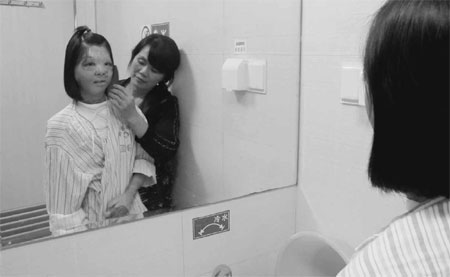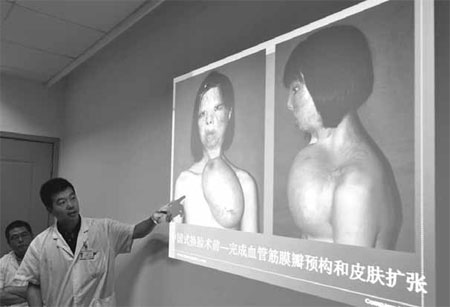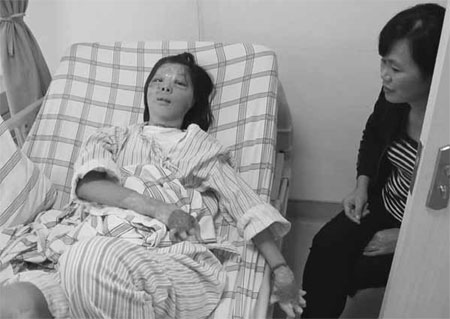Face of the future
Updated: 2013-11-07 06:54
By Sun Li and Hu Meidong (China Daily)
|
||||||||
A new surgical technique has given a badly burned young Chinese woman a new lease on life - with a transplant from her own body. Sun Li and Hu Meidong report in Fuzhou.
The face transplant between Nicolas Cage and John Travolta in the 1997 action thriller Face/Off still impresses today's viewers. But a recent real-life surgery that allowed the patient to have a new face grown on another part of her own body seems more likely to wow the public.
Xu Jianmei, a 17-year-old burn victim from Fujian province, has received a face transplant that was grown on an area between her shoulder and chest in Fuzhou, the provincial capital.
Dr Jiang Chenghong, a surgeon with the Fujian Medical University Union Hospital's orthopedics department, one of the chief doctors for Xu, says the first time he saw the girl, he realized ordinary plastic surgery could not help her.
Xu was hideously disfigured in a blaze 12 years ago, but she missed the optimal treatment time as her family could not afford it.
When Xu came to the hospital last August, the ridged scars on her face were deep enough to affect her eating and facial expressions, Jiang recalls. He regarded a face transplant as the only option for Xu.
The surgery was inspired by similar operations performed by doctors at the Shanghai Ninth People's Hospital affiliated with the Shanghai Jiao Tong University School of Medicine, Jiang says.
Last year, the Shanghai hospital announced its breakthrough using people's own skin to grow a new face for seriously disfigured patients, but no photos, papers and other forms of documentation have been shown yet, Jiang says.
After studying the technology in the Shanghai hospital, Jiang proposed the idea of growing a new face on Xu's own body. It initially aroused some debate.
"After all, no one in the Fujian hospital or any other hospitals in the province had done it before. It's novel and it's highly risky," Jiang says.
The medical team for Xu's case included six doctors with the orthopedics department, who held several meetings and seminars before they eventually agreed on a three-phrase operation plan.
Phase 1 was to take a piece of blood-vessel fascia (tissue that surrounds vessels and muscles) from Xu's right thigh and implant it in an area between her shoulder and chest. A skin dilator was inserted beneath the part of skin where the blood vessel fascia was planted.
Phase 2 was to let the skin dilator expand the skin and produce enough new tissue for the new face.
Finally, Phase 3: Transplant the new face and mold the shape.
"The skin color of the area between the shoulder and chest is more identical to the face's skin color, compared with other parts of a human body. The area is also close to the face, so it would be convenient when performing the final face transplant," Jiang explains.
The procedure of implanting the fascia, which is known as the flap prefabrication, was the most difficult and crucial part of the whole plan, Jiang says, adding it required connecting blood vessels grafted from the thigh with the ones in the face.
"The diameter of a blood vessel is about a millimeter, so the dovetailing of the blood vessels in the connecting parts required me to do the stitching with a thread thinner than a hair under the microscope," Jiang says.
Although Jiang practiced such stitching many times when he studied the technology in the Shanghai hospital, he admits he felt tremendous pressure.
"The hours of stitching were nerve-wracking. I held my breath to maintain the pace. If the blood vessels failed to properly grow onto one another, the whole plan would fail from the start," Jiang says.
Phase 1 was completed on Nov 26, 2012.
For the second phase, doctors injected water into the skin dilator twice a week and the dilator gradually became a bulging ball.
"The bigger the dilator was, the thinner the skin would be. The challenge was to protect the dilator from being broken," Jiang says.
Ke Haiying, Xu's mother, said that while monitoring the dilator, she could barely sleep at night.
"I was afraid that my girl would toss about in bed or scratch herself," Ke says.
The phase lasted for about nine months, and toward the end doctors also screened the blood vessels to ensure the tissue was viable.
On Oct 14, Xu underwent her final operation, which lasted for about 10 hours.
Guo Zhihui, director of the orthopedics department, says patients receiving the traditional face transplant, which involves a recipient and a deceased donor, always faced problems such as ethical issues and infections caused by the rejection.
"This Chinese-developed style of facial reconstruction has none of these concerns and it opens up a new window for people disfigured in an attack, a car crash, a fire or a tumor," Guo says, adding the surgery could be a milestone of the country's medical technology.
According to Guo, Xu still has mimetic muscles and subcutaneous tissue, so she will still be able to make facial expressions after healing.
Over the next several weeks, doctors will treat the wounds left by the surgery and make some embellishments, such as an eyebrow transplant, to make the new face as pleasing and natural-looking as possible, Guo says.
Xu is in a stable condition now and looking forward to leading a normal life.
"Finally, I can face the future," Xu says.
Contact the writers through sunli@chinadaily.com.cn.
|
After the surgery, Xu Jianmei, accompanied by her mother Ke Haiying, finally dares to look at a mirror and smiles for the first time in 12 years. Sun Li / China Daily |
|
The medical team for Xu's case has a meeting before Xu's final transplant operation. Lin Dan / for China Daily |
|
Xu Jianmei rests in bed after surgery. Sun Li / China Daily |
(China Daily 11/07/2013 page20)

 Post-baby Duchess
Post-baby Duchess
 Victoria Beckham S/S 2014 presented during NYFW
Victoria Beckham S/S 2014 presented during NYFW
 'Despicable' minions upset Depp's 'Lone Ranger' at box office
'Despicable' minions upset Depp's 'Lone Ranger' at box office
 'Taken 2' grabs movie box office crown
'Taken 2' grabs movie box office crown
 Rihanna's 'Diamonds' tops UK pop chart
Rihanna's 'Diamonds' tops UK pop chart
 Fans get look at vintage Rolling Stones
Fans get look at vintage Rolling Stones
 Celebrities attend Power of Women event
Celebrities attend Power of Women event
 Ang Lee breaks 'every rule' to make unlikely new Life of Pi film
Ang Lee breaks 'every rule' to make unlikely new Life of Pi film
Most Viewed
Editor's Picks
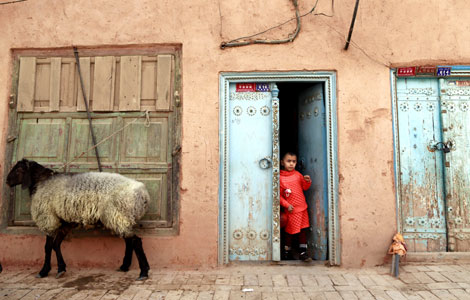
|

|

|

|

|
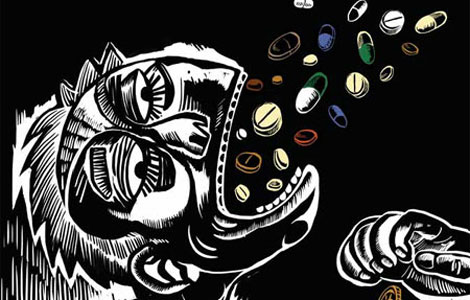
|
Today's Top News
World to see boom in big firms
U. Michigan gets grant for China center
Lead author of Obamacare law blames govt for rollout
China's increasing role in global nuclear power
US companies in China feel squeeze
Panda cub drawing votes for her name
US, China team up for wildlife
E China still top draw for foreigners
US Weekly

|

|
